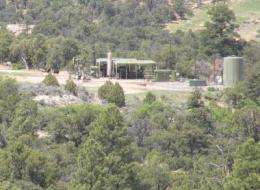Large birds with low-frequency songs are less likely to nest near noisy sites

A growing body of evidence shows that man-made noise is bad for birds, but some species are harder hit than others — particularly bigger birds with low-frequency songs, finds a new study.
"Bigger birds sing at frequencies that are more easily masked by the low frequencies typical of human noise pollution," said lead author Clinton Francis of the National Evolutionary Synthesis Center in Durham, North Carolina.
The findings aren't just important for birds. The larger species in Francis's study, for example — such as western scrub jays and pinyon jays — are also important seed dispersers for trees like pines and oaks, which could be bad news for tree seedlings too.
The study appears in the November 9 issue of PLoS ONE.
Birds rely on sound to find mates and avoid danger. Human-generated noise can make it harder for birds to hear each other's chirps, whistles and trills. Think of the roar of traffic or the hum of machinery.
Since the 1980s, studies have documented decreases in bird density near roads and other noisy areas. Francis and his colleagues are trying to pinpoint what might be causing these declines, and whether some species fare worse than others.
From 2005 to 2007, Francis and his team counted birds and nests in the Bureau of Land Management's Rattlesnake Canyon Wildlife Area in northern New Mexico.
The region is home to thousands of natural gas wells, many of which are coupled with noisy compressors for extracting the gas and transporting it through pipelines.
The compressors are present on some wells but absent from others. The advantage of working in natural gas sites is they allow the scientists to study noise and its effects on wildlife without many of the confounding factors often associated with noisy areas like roadways or cities, such as pollution from light or chemicals or collisions with cars.
"Previous studies haven't been able to tease apart noise from all the other factors that could also affect birds," Francis said.
At noisy wells the compressors run 24 hours a day, 365 days a year. The constant roar and rumbling is about 80 decibels — as loud as a motorcycle less than 50 feet away.
The researchers surveyed birds at noisy sites with compressors and quiet sites without them. For each species in their study — 30 species including the black-chinned hummingbird, common poorwill, pinyon jay and western scrub jay — they also recorded its song using a shotgun microphone.
Species with low frequency songs were less likely to defend territories or build nests near noisy machinery, the researchers report. "Some species are opting not to breed in these areas, and others aren't going there at all," Francis said.
These birds may be forced out of noisy sites because they can't hear each other over the din, he added. Most anthropogenic noise is lower in frequency and more constant than noise found in nature. "Species whose songs overlap with the frequency range of man-made noise should be more sensitive," Francis said.
Worst hit were bigger birds such as the western tanager, black-headed grosbeak and mourning dove, because large birds sing lower songs that are more likely to be drowned out.
"The results were surprising because larger birds are also typically louder," Francis said. Despite singing at higher volumes than their smaller cousins, bigger birds with deeper voices are still harder hit.
Smaller, higher singers such as the chipping sparrow and the house finch stayed behind, presumably because their higher ballads stand out better.
The phenomenon may be aggravated by the fact that bigger birds also have larger territories, which means their songs have to span a larger area.
For Francis and his team, the next step is to compile bird data from roughly two hundred species living in other types of noisy sites to see if they show the same pattern. "This may not be restricted to oil and gas lands in New Mexico. We'd like to know if we see the same trend in response to city and traffic noise, and man-made noise more generally," Francis said.
More information: Francis, C., C. Ortega, et al. (2011). "Noise pollution filters bird communities based on vocal frequency." PLoS ONE (2011).
Journal information: PLoS ONE
Provided by National Evolutionary Synthesis Center (NESCent)
















